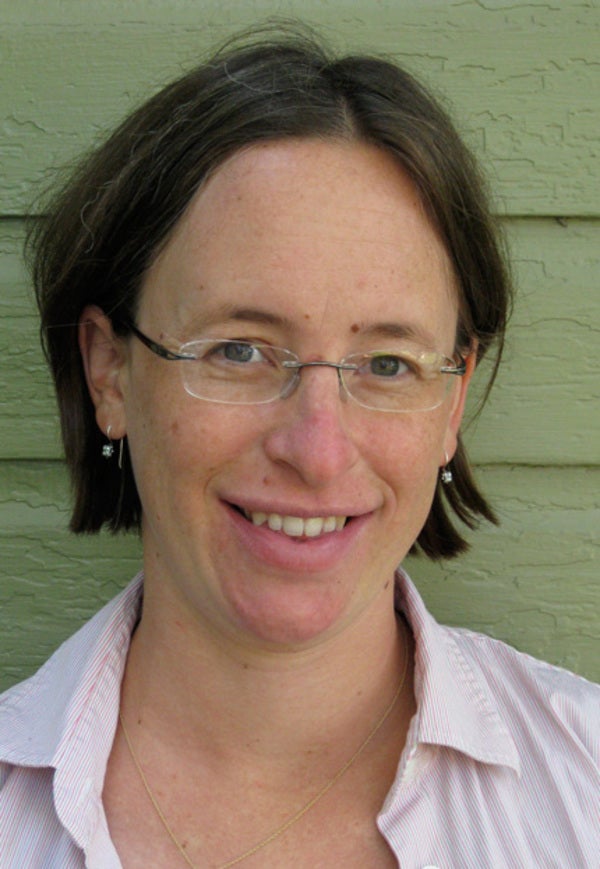Laura Peterson

About
Laura Peterson has been a professor in the Environmental Studies program since 2008, and is also affiliated with the Chemistry Department. As an Earth scientist with a research background in paleoclimatology and paleoceanography, her interests include climate science and the history of the Earth system. Some of her course topics include Environmental Geology, Introduction to Geographic Information Systems, and Earth: Evolution of a Habitable Planet. She also teaches field geology courses as part of Luther’s Earth & Environment in Italy study abroad program.
Peterson’s research entails generating records of past changes in ocean temperature in order to understand how the climate system has changed over the last several million years, which in turn is one way to provide insight into current and future climate behavior under anthropogenic influence. With funding from the National Science Foundation, Peterson and student researchers are currently at work generating a 6 million year long record of sea surface temperature change in the southwest Pacific Ocean, the first of its kind from this region.
ENVS 134 Environmental Geology
Just as the physical environment impacts human activities, so too do our actions influence our surroundings. In this course we will seek to understand geologic processes and the ways in which humans interact with them. We will also explore the unique geology and physical geography of northeast Iowa during labs and field trips.
ENVS 175 Introduction to Geographic Information Systems
This course is an applied practicum in geospatial technology that fosters effective use of Geographic Information Systems. Students who successfully complete the course will be able to create, manipulate, and manage geographic data to perform analysis tasks, to visualize geographic data, and to use geographic data analyses to support decision making.
ENVS 310. Earth: Evolution of a Habitable Planet
Among the planets of our solar system, the Earth alone has remained hospitable to life throughout its long history. What processes and feedbacks have consistently maintained conditions on the Earth’s surface within the bounds required for survival of life? From the earliest Earth to the modern day, we will explore the intertwined histories of life, atmospheric chemistry, geologic processes, and the climate system. Additional emphasis on the scientific techniques used to reconstruct Earth history. Laboratory includes field trips exploring regional geology.
Italy Semester Courses
ENVS 230: Earth Systems and the Environment
This course focuses on 1) the operation of the biosphere, lithosphere, hydrosphere and atmosphere within the context of the Earth system as a whole, 2) how the operation of these systems may change over time and 3) how human activities influence and are influenced by these systems. We will draw on the immense field laboratory of the Italian peninsula to explore Earth system processes from the deep geologic past to the present. Course work will be based primarily on field observations and analysis. (Offered as part of the Earth and Environment in Italy program.)
ENVS 330 Geology of Italy
Although Italy’s geology, like much of the American Midwest, is characterized in large part by limestone bedrock, the landscape and geological history of Italy are unlike anything encountered in the central United States. In this course we will learn techniques for deciphering the sometimes complex geologic history recorded in the rocks of Italy, and will use these techniques to reconstruct events of mountain building, crustal deformation, igneous activity, metamorphism, erosion, extraterrestrial impacts, and climate and environmental change that have shaped the geology and landscape that we see today on the Italian peninsula. (Offered as part of the Earth and Environment in Italy program.)
Ph.D., Geological Sciences, Brown University, 2009
Thesis: “A tropical perspective on Plio-Pleistocene climate evolution and new application of the alkenone sea surface temperature proxy to uplifted marine strata.”
M.Sc., Geological Sciences, Brown University, 2005
Thesis: “High latitude control on tropical Atlantic and Arabian Sea SST during the early Pleistocene.”
B.A., Geology, Carleton College, 2001
Thesis: Calcium carbonate and magnetic susceptibility analysis at Monte dei Corvi, Italy:Trends in the Mediterranean climate proxy record during middle Miocene ice sheet expansion.
Herbert, T. D., K.T. Lawrence, A. Tzanova, L.C. Peterson, R. Caballero-Gill, and C.S. Kelly, (2016). Late Miocene global cooling and the rise of modern ecosystems. Nature Geoscience, v. 9. p. 843-847, doi:10.1038/ngeo2813.
Fedorov, A.V., N.J. Burls, K.T. Lawrence, and L.C. Peterson, 2015. Tightly linked zonal and meridional sea surface temperature gradients over the past five million years, Nature Geoscience, v. 8, p. 975-980, doi: 10.1038/ngeo2577.
Herbert, T.D., G. Ng, and L.C. Peterson, 2015. Evolution of Mediterranean sea surface temperatures 3.5-1.5 Ma: Regional and hemispheric influences, Earth and Planetary Science Letters, v. 409, p. 307-318, doi: 10.1016/j.epsl.2014.10.006.
Herbert, T.D., L.C. Peterson, K.T. Lawrence, and Z. Liu, 2010. Tropical ocean temperatures over the past 3.5 million years, Science, v. 328, p. 1530-1534, doi: 10.1126/science.1185435. (pdf)
Cleaveland, L.C. and T.D. Herbert, 2009. Preservation of the alkenone paleotemperature proxy in uplifted marine sequences: a test from the Vrica outcrop, Crotone, Italy, Geology, v. 37(2), p. 179-182, doi: 10.1130/G25148A.1
Cleaveland, L.C. and T.D. Herbert, 2007. Coherent obliquity band and heterogeneous precession band responses in early Pleistocene tropical sea surface temperatures. Paleoceanography, v. 22, PA2216, doi:10.1029/2006PA001370.